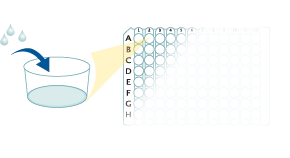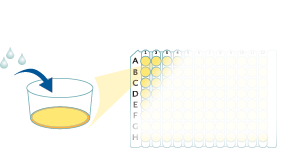Mouse/Rat SOST/Sclerostin Quantikine ELISA Kit Summary
Product Summary
Precision
Cell Culture Supernates, Serum, EDTA Plasma, Heparin Plasma
| Intra-Assay Precision | Inter-Assay Precision | |||||
|---|---|---|---|---|---|---|
| Sample | 1 | 2 | 3 | 1 | 2 | 3 |
| n | 20 | 20 | 20 | 20 | 20 | 20 |
| Mean (pg/mL) | 57.6 | 108 | 345 | 54.4 | 101 | 347 |
| Standard Deviation | 4.15 | 6 | 18.7 | 4.35 | 6.23 | 19.4 |
| CV% | 7.2 | 5.6 | 5.4 | 8 | 6.2 | 5.6 |
Recovery
The recovery of SOST spiked to levels throughout the range of the assay in various matrices was evaluated.
| Sample Type | Average % Recovery | Range % |
|---|---|---|
| Cell Culture Samples (n=4) | 101 | 92-112 |
| Mouse EDTA Plasma (n=4) | 98 | 82-113 |
| Mouse Heparin Plasma (n=4) | 102 | 88-115 |
| Mouse Serum (n=4) | 95 | 86-113 |
| Rat EDTA Plasma (n=2) | 107 | 101-118 |
| Rat Heparin Plasma (n=2) | 96 | 82-111 |
| Rat Serum (n=4) | 99 | 85-116 |
Linearity
Scientific Data
Product Datasheets
Preparation and Storage
Background: SOST/Sclerostin
SOST, also known as Sclerostin, is a Cerberus/DAN family BMP antagonist and is an important regulator of bone homeostasis. Inactivating mutations in the SOST gene can cause sclerosteosis and van Buchem disease. SOST is expressed by terminally differentiated cells embedded in mineralized matrix including osteocytes, hypertrophic and prehypertrophic chondrocytes, and tooth cementocytes. Its expression is induced by BMP-2, -4, and -6 and is inhibited by parathyroid hormone (PTH). Its downregulation in osteocytes by physical loading of bone contributes to the mechanical sensor function of osteocytes and the subsequent increase in bone growth. SOST binds to BMP-2, -4, -5, -6, and -7 and inhibits the osteogenic differentiation induced by these BMPs. It inhibits canonical Wnt signaling by binding to LRP-5 and LRP-6 and inhibiting their association with Frizzled receptors. SOST reduces the proliferation of mesenchymal stem cells (MSC) and induces MSC apoptosis. Circulating levels of SOST are elevated in pathologies with bone involvement including low bone mineral density, Paget’s disease, multiple myeloma, and prostate cancer with bone metastases. It is also elevated in advanced chronic kidney disease, alcoholic liver disease, type 2 diabetes, and patients with increased abdominal and gynoid fat.
Assay Procedure
Refer to the product- Prepare all reagents, standard dilutions, control, and samples as directed in the product insert.
- Remove excess microplate strips from the plate frame, return them to the foil pouch containing the desiccant pack, and reseal.
- Add 50 µL of Assay Diluent to each well.
- Add 50 µL of Standard, control, or sample to each well. Cover with a plate sealer, and incubate at room temperature for 3 hours.
- Aspirate each well and wash, repeating the process 4 times for a total of 5 washes.
- Add 100 µL of Conjugate to each well. Cover with a new plate sealer, and incubate at room temperature for 1 hour.
- Aspirate and wash 5 times.
- Add 100 µL Substrate Solution to each well. Incubate at room temperature for 30 minutes. PROTECT FROM LIGHT.
- Add 100 µL of Stop Solution to each well. Read at 450 nm within 30 minutes. Set wavelength correction to 540 nm or 570 nm.





Citations for Mouse/Rat SOST/Sclerostin Quantikine ELISA Kit
R&D Systems personnel manually curate a database that contains references using R&D Systems products. The data collected includes not only links to publications in PubMed, but also provides information about sample types, species, and experimental conditions.
13
Citations: Showing 1 - 10
Filter your results:
Filter by:
-
Characterization of sclerostin's response within white adipose tissue to an obesogenic diet at rest and in response to acute exercise in male mice
Authors: N Kurgan, B Baranowski, J Stoikos, AJ MacNeil, VA Fajardo, REK MacPherson, P Klentrou
Frontiers in Physiology, 2023-01-04;13(0):1061715.
Species: Mouse
Sample Types: Serum
-
Osteocytic cells exposed to titanium particles increase sclerostin expression and inhibit osteoblastic cell differentiation mostly via direct cell-to-cell contact
Authors: H Chai, ZH Zhang, JY Fang, C She, C Geng, W Xu
Journal of Cellular and Molecular Medicine, 2022-06-28;0(0):.
Species: Mouse
Sample Types: Cell Culture Supernates
-
Sp7 Transgenic Mice with a Markedly Impaired Lacunocanalicular Network Induced Sost and Reduced Bone Mass by Unloading
Authors: T Moriishi, T Ito, R Fukuyama, X Qin, H Komori, H Kaneko, Y Matsuo, N Yoshida, T Komori
International Journal of Molecular Sciences, 2022-03-15;23(6):.
Species: Mouse
Sample Types: Serum
-
Subcutaneous adipose tissue sclerostin is reduced and Wnt signaling is enhanced following 4-weeks of sprint interval training in young men with obesity
Authors: N Kurgan, H Islam, JBL Matusiak, BJ Baranowski, J Stoikos, VA Fajardo, REK MacPherson, BJ Gurd, P Klentrou
Physiological Reports, 2022-03-01;10(6):e15232.
Species: Human
Sample Types: Serum
-
Novel Aptamer-Based Small-Molecule Drug Screening Assay to Identify Potential Sclerostin Inhibitors against Osteoporosis
Authors: CC Lee, CM Hung, CH Chen, YC Hsu, YP Huang, TB Huang, MJ Lee
International Journal of Molecular Sciences, 2021-08-02;22(15):.
Species: Mouse
Sample Types: Cell Culture Supernates
-
Sclerostin expression in trabecular bone is downregulated by osteoclasts
Authors: M Koide, T Yamashita, K Murakami, S Uehara, K Nakamura, M Nakamura, M Matsushita, T Ara, H Yasuda, JM Penninger, N Takahashi, N Udagawa, Y Kobayashi
Sci Rep, 2020-08-13;10(1):13751.
Species: Mouse
Sample Types: Bone Marrow Fluid, Whole Tissue
-
Influences of donor and host age on human muscle-derived stem cell-mediated bone regeneration
Authors: X Gao, A Lu, Y Tang, J Schneppend, AB Liebowitz, AC Scibetta, ER Morris, H Cheng, C Huard, S Amra, B Wang, MA Hall, WR Lowe, J Huard
Stem Cell Res Ther, 2018-11-21;9(1):316.
Species: Mouse
Sample Types: Serum
-
Osteoblastic Lrp4 promotes osteoclastogenesis by regulating ATP release and adenosine-A2AR signaling
Authors: L Xiong, JU Jung, HH Guo, JX Pan, XD Sun, L Mei, WC Xiong
J. Cell Biol, 2017-02-13;0(0):.
Species: Mouse
Sample Types: Cell Culture Supernates
-
Acute Phosphate Restriction Impairs Bone Formation and Increases Marrow Adipose Tissue in Growing Mice
Authors: Frank C Ko
J Bone Miner Res, 2016-11-07;0(0):.
Species: Mouse
Sample Types: Serum
-
Short-term intermittent administration of parathyroid hormone facilitates osteogenesis by different mechanisms in cancellous and cortical bone
Authors: K Ogura, T Iimura, Y Makino, A Sugie-Oya, A Takakura, R Takao-Kawa, T Ishizuya, K Moriyama, A Yamaguchi
Bone Rep, 2016-01-16;5(0):7-14.
Species: Rat
Sample Types: Serum
-
Sclerostin inhibition prevents spinal cord injury-induced cancellous bone loss.
Authors: Beggs L, Ye F, Ghosh P, Beck D, Conover C, Balaez A, Miller J, Phillips E, Zheng N, Williams A, Aguirre J, Wronski T, Bose P, Borst S, Yarrow J
J Bone Miner Res, 2015-04-01;30(4):681-9.
Species: Rat
Sample Types: Serum
-
Androgens inhibit the osteogenic response to mechanical loading in adult male mice.
Authors: Sinnesael M, Laurent M, Jardi F, Dubois V, Deboel L, Delisser P, Behets G, D'Haese P, Carmeliet G, Claessens F, Vanderschueren D
Endocrinology, 2015-02-05;156(4):1343-53.
Species: Mouse
Sample Types: Serum
-
Role of TGF-beta in a mouse model of high turnover renal osteodystrophy.
Authors: Liu S, Song W, Boulanger J, Tang W, Sabbagh Y, Kelley B, Gotschall R, Ryan S, Phillips L, Malley K, Cao X, Xia T, Zhen G, Cao X, Ling H, Dechow P, Bellido T, Ledbetter S, Schiavi S
J Bone Miner Res, 2014-01-01;29(5):1141-57.
Species: Mouse
Sample Types: Serum
FAQs
No product specific FAQs exist for this product, however you may
View all ELISA FAQsReviews for Mouse/Rat SOST/Sclerostin Quantikine ELISA Kit
Average Rating: 5 (Based on 2 Reviews)
Have you used Mouse/Rat SOST/Sclerostin Quantikine ELISA Kit?
Submit a review and receive an Amazon gift card.
$25/€18/£15/$25CAN/¥75 Yuan/¥2500 Yen for a review with an image
$10/€7/£6/$10 CAD/¥70 Yuan/¥1110 Yen for a review without an image
Filter by:




